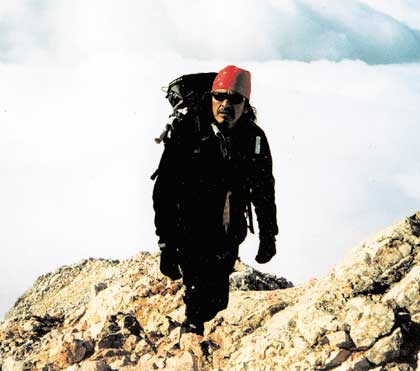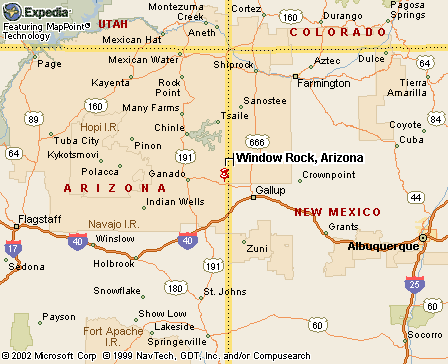|
|
Canku Ota |
|
|
(Many Paths) |
||
|
An Online Newsletter Celebrating Native America |
||
|
April 17, 2004 - Issue 111 |
||
|
|
||
|
Spirit of the Mountains |
||
|
by Jan-Mikael Patterson - The
Navajo Times
|
||
|
credits: photo:
Richard Manson atop Slovenia's highest mountain, Triglav, which
is 2,864 meters (9,396 feet) high Oct. 2, 2003. Manson is currently
attepting to climb the highest mountain in the world, Mount Everest.
(Courtesy photo)
|
|
Climber finds peace, spirituality after loss of beloved grandfather
Manson, 43, has been living in Slovenia since August. Slovenia is part of Yugoslavia but Manson said that 12 years ago the country went independent after the collapse of the Yugoslav Federation. A painter and sculptor, he moved there after being invited to teach. His curiosity about the country increased his decision to move there. "It's east of Italy," Manson said in a telephone interview. "I've been here off and on for four years. It has been a journey." About half of Slovenia is mountainous. The Alps, the Julian and Savinja ranges run along the northwest border of the country. Slovenia's highest peak is Triglav with an elevation of 2,864 meters (9,396 feet). Manson climbed to the top of Triglav on Oct. 2, 2003. "I couldn't sleep that night," he said. "I felt like I was near the spirits. I never experienced anything like this before." Manson said he felt like he was close to the Creator. "It's almost as if you were in connection with a spirit," he said. "That's where I began thinking about the word 'Diné' and what it means. My grandfather, Big Mountain Begay, shared a strong story about 'Dzil Biyiin.' "When you climb you experience a certain energy," Manson said. "I'm not even sure where to begin. The mountain has a really strong effect. There's a greater purpose for the Diné on this earth." Coming from such mountains and the atmosphere, the health shortcomings of the Navajo people were more obvious. "When I came home in July I surprised to see that most people are overweight," he said. "They are struggling and they are not able to move. They're struggling to move like they are disabled. That was shocking for me. That's why I say there's a greater purpose for the Diné." On March 25 Manson began an attempt to climb to the top of Mount Everest, dubbed the highest point in the world. The elevation of the peak is 29,035 feet. He started at the south slope in Nepal. He said the climb would take a month. He plans to gradually go higher in elevation to increase his endurance. By late April, he plans to reach the summit. "It's going to take a month because I have to adjust to the altitude because the air is thinner," Manson said. "I'm going to gradually prepare to adjust to the altitude. I'm physically prepared. "I feel like I've never been this prepared before," he said about his physical condition. "I feel like I'm in my twenties." Manson's love for rock climbing began when he moved to Slovenia. He said the horizon is rugged with jagged mountains. "Back home we don't have mountains this big," he said. Manson is originally from Hard Rock, Ariz. He is Tl'izilani (Many Goats Clan), born for Ta'néészahnii (Badlands Clan). His chei is Deeschiinii (Start of the Red Streaked People Clan) and his nali is Taachii'nii (Red Running into Water Clan). His mother is Dora Manson from Hard Rock and his father is Joe Manson of Tuba City. His late grandfather, Big Mountain Begay, predicted Manson's current journey. "One day he said you would be in a place of high mountains and a lot of water," Manson chuckled. "We were in a cornfield when he said that. I was looking around and thought, 'There's no water here.'" Begay died in the spring of 2002. Manson fell into a depression and moved away. He chose to live in solitude. "I didn't call home for about two years," Manson said. "I know that worried my mom. I just came home one day out of the blue." Rock climbing was his form of therapy. "It's a different lifestyle, a different way of life," Manson said. "I couldn't deal with how fast my lifestyle changed." But with rock climbing his focus on life was restored. "Every moment became a ceremony," he said about rock climbing. "That's how strong it is, the feeling you get when you're on top. "I never knew the meaning of the word freedom," Manson said. "Now after experiencing all of this I know what the word means. The mountains have strong positive effects. In a way I feel like I was deteriorating with sickness. "But when I started going to the mountains it took my sickness away," he said. Manson plans to return home in July to visit his family. He also plans to sit with a medicine man and share the experiences he felt from climbing. "This is very strong," said Manson. "I don't know where or how to begin speaking of the energy I felt. When I climb Mount Everest I won't see it as a challenge. I'll see it as a ceremonial thing with respect." |
|
|
www.expedia.com |
|
|
||
|
|
||
| Canku Ota is a free Newsletter celebrating Native America, its traditions and accomplishments . We do not provide subscriber or visitor names to anyone. Some articles presented in Canku Ota may contain copyright material. We have received appropriate permissions for republishing any articles. Material appearing here is distributed without profit or monetary gain to those who have expressed an interest. This is in accordance with Title 17 U.S.C. Section 107. | ||
|
Canku Ota is a copyright © 2000, 2001, 2002, 2003, 2004 of Vicki Lockard and Paul Barry. |
||
 |
 |
|
|
The "Canku Ota - A Newsletter Celebrating Native America" web site and its design is the |
||
|
Copyright © 1999, 2000, 2001, 2002, 2003, 2004 of Paul C. Barry. |
||
|
All Rights Reserved. |
||
 WINDOW
ROCK - There is something spiritual about the mountains in the Alps
near Slovenia and the only way Richard Manson can describe it is
in reference to "Dzil Biyiin."
WINDOW
ROCK - There is something spiritual about the mountains in the Alps
near Slovenia and the only way Richard Manson can describe it is
in reference to "Dzil Biyiin."